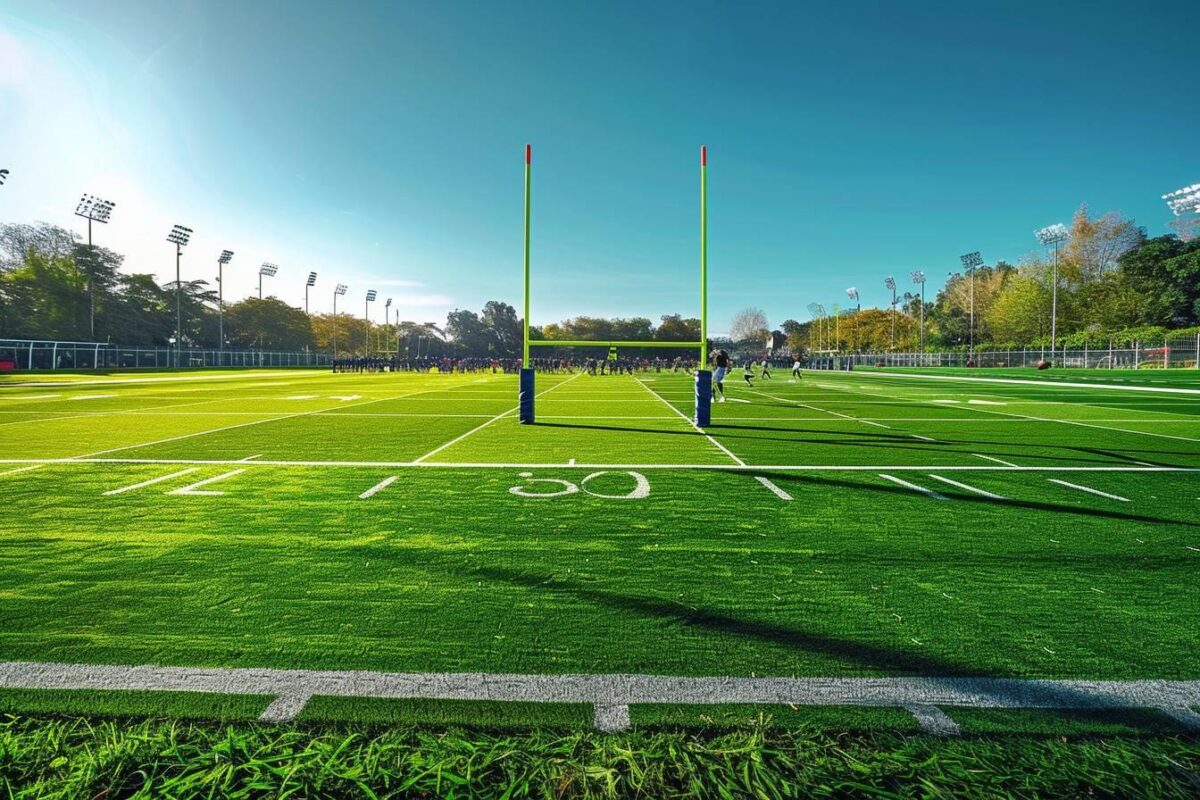Show table of content Hide table of content
Football fields are iconic spaces where thrilling games unfold, but have you ever wondered about their exact dimensions ? Understanding the layout and measurements of a football field is crucial for players, coaches, and fans alike. Let’s dive into the specifics of how many feet make up a standard football field and explore its various components.
Standard dimensions of a football field
A football field’s size is precisely defined to ensure fair play across all levels of the sport. The total length of a standard football field is 360 feet, which is equivalent to 120 yards. This measurement includes two critical areas :
- The main playing field : 300 feet (100 yards) long
- Two end zones : Each measuring 30 feet (10 yards) deep
When it comes to width, a football field spans 160 feet, or 53.3 yards. This consistent width applies to fields used in high school, college, and professional NFL games. The uniformity in dimensions ensures that players can seamlessly transition between different levels of play without adjusting to new field sizes.
To put these measurements into perspective, the total area of a football field is an impressive 57,600 square feet. This is roughly equivalent to 1.32 acres, which is about the size of a small farm or a large suburban lot. It’s fascinating to think that such a vast space is dedicated to a single sporting event, much like how the Eiffel Tower’s height in feet captivates visitors with its imposing stature.
Key markings and features of the field
The layout of a football field is not just about its overall dimensions. Various markings and features are essential for gameplay and officiating. Here’s a breakdown of the key elements you’ll find on a standard football field :
Yard lines and numbers : The field is marked with lines every 5 yards, with numbers appearing at 10-yard intervals. These markings help players and officials quickly gauge distances during play. The yard numbers are typically placed 27 feet from the sidelines, ensuring clear visibility from various angles.
Hash marks : These shorter lines indicate individual yards and vary in spacing depending on the level of play :
| Level | Hash Mark Spacing |
|---|---|
| High School | 53 feet 4 inches apart |
| College | 40 feet apart |
| NFL | 18 feet 6 inches apart |
Sidelines and end lines : These boundaries are typically 6 feet wide and clearly mark the playable area of the field. They serve as crucial reference points for players and officials to determine if a play is in-bounds or out-of-bounds.
Field crown : For proper drainage, the field is usually crowned, rising about 20 inches from the sidelines to the center. This subtle slope helps prevent water accumulation during rainy conditions, ensuring safer gameplay.
Understanding these markings is as crucial as knowing how many cups are in a pound of sugar is for baking. Both require precision and attention to detail for optimal results.

Goalposts and end zone specifications
The end zones and goalposts are vital components of a football field, playing a crucial role in scoring. Let’s examine their specifications :
End zones : Each end zone measures 30 feet (10 yards) deep and spans the full width of the field. These areas are where touchdowns are scored and are often decorated with team colors or logos.
Goalposts : Centered on each end line, goalposts have specific dimensions :
- Crossbar height : 10 feet
- Total height : Varies between 30-35 feet depending on the level of play
- Width : 18 feet 6 inches for college and NFL, 23 feet 4 inches for high school
The goalposts serve as targets for field goal and extra point attempts, adding an element of precision to the game. Their presence at each end of the field is as constant as the number of active volcanoes in the world, always ready to play their part in the excitement of the game.
Variations in field size and layout
While the standard dimensions apply to most official games, there are variations worth noting :
Youth football fields : Recognizing the physical limitations of younger players, youth football fields are typically smaller. These modified fields range from 50 to 80 yards in length, allowing for appropriate gameplay for developing athletes.
NFL FLAG fields : Designed for even younger players, these fields measure 210 feet (70 yards) in length and 90 feet (30 yards) in width. This reduced size ensures that younger children can fully participate and enjoy the game without being overwhelmed by the scale of a full-sized field.
Field surface : While dimensions remain constant, the playing surface can vary. Fields may be natural grass or artificial turf, each with its own characteristics affecting gameplay. The choice of surface often depends on factors such as climate, maintenance requirements, and local preferences.
Decorative elements : Many fields incorporate decorative lines or logos at the 20 or 25-yard lines, and team or league logos are frequently painted at the 50-yard line. These additions personalize the field without altering its fundamental dimensions or gameplay areas.
News This rare fish found in the United States is said to be a harbinger of major natural disasters.
Understanding these variations helps appreciate the adaptability of football as a sport, catering to different age groups and playing conditions while maintaining the essence of the game. Whether it’s a professional stadium or a local school field, the basic structure remains recognizable, fostering a universal language for football enthusiasts worldwide.


